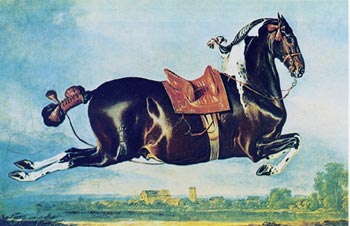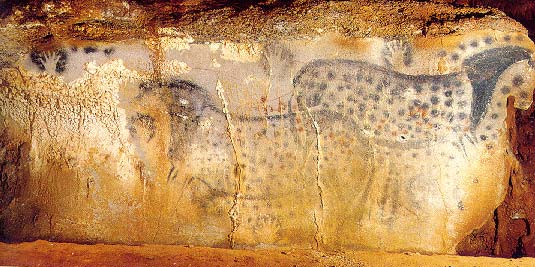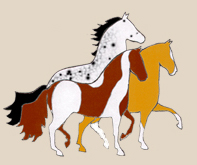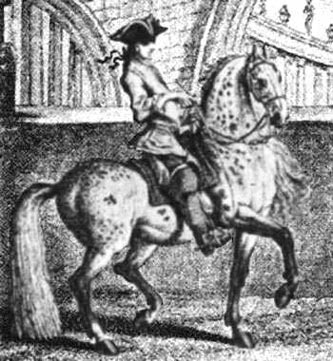 | ||||

For information on registering your Paso horse with Pintado or Atigrado characteristics
Contact us at:.
Welcome to the Official website of the Spanish Jennet Horse and
the Spanish Jennet Horse Society!
"Look back on man's struggle for freedom.
Trace our present day strength to it's source, You'll find that man's pathway to glory
Is strewn with the bones of the horse..."
Author Unknown
History
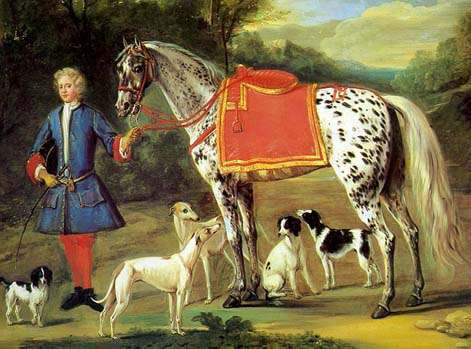
The 18th C. English painter John Wooton painted many spotted horses including a leopard horse specifically titled "Lady Conaway's Spanish Jennet".
It is well established through a multitude of examples in art that horses of the exotic patterns of Pintado ( pinto ) and Atigrado ( Leopard-complex ) not only existed, but were treasures in many civilizations as far back as the Aurignacian-Perigordian culture (cave dwellers) of 18,000 BC. Paleolithic animal art (15,000 - 10,000 BC) found in the cave paintings of Altamira, Spain and Lascaux, France show horses with exotic coat patterns.
The history of the Spanish Jennet horse began in Ancient Spain and developed in Medieval Spain as the product of the chance collision of several worlds and their horses. The mingling of these cultures and their mounts sparked the flame that became
the world's finest riding horse - the Spanish Jennet.
About 3,500 years ago, somewhere in the steppe region of Asia, horses were domesticated. The spotted horses were especially eye-catching and so they frequently became models for the local artisans. Some of those relics have endured to present day leaving us some record of horses during ancient times.
Throughout history, in all civilizations and cultures the spotted horses are usually depicted as the mount of a person of stature, indicating that the spotted horses were much admired and prized by persons of rank and wealth.
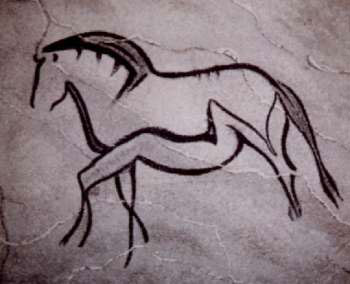
Around 1000 BC, constantly in search of lush pasture for their herds, a nomadic tribe from the steppe region known as Scythia (area lying on the Black Sea between the mouths of the Danube and the Don Rivers) migrated westward; along the banks of the Danube River. These peoples were consummate horsemen. The modern day town of Hallstatt, Austria now occupies the area of the nomad's settlement. All that remains of the nomadic people
is an ancient burial area, rich in archeological finds, bespeaking the nature of that early migrated culture. A sword dating to @800 BC specifically depicts horses with spots.
India has been invaded from Afghanistan via the Kyber pass since pre-historic times. Spotted horses could have come with any of the invading armies including those of Darius I of Persia, Alexander (the Great) of Macedonia or the Moguls (Ottoman Dynasty) of the 13th C AD, but the Mogul paintings of the late 16thC are very specific about the presence of spotted horses.
In an Etruscan tomb in Italy, dated about the same time - 800 BC, exists a wall painting depicting a horse with a spotted rump. Since the Etruscans came to Italy by ship @1000 BC they likely had brought those horses with them from Asia Minor, the steppe region.
About 875 BC the Phoenician colony of Carthage, located on the north coast of Africa, dominated trade in the western Mediterranean. Carthage traded with Britain and the Baltic area, eventually encroaching on the Greek colonies in Sicily. Defeated by Romans in the First Punic War (264 - 241 BC) the Carthaginians of northern Africa turned their energies to the conquest and occupation of the Iberian Peninsula - Spain and Portugal. The new possessions were protected by the highly efficient army of her general, Hamilcar. Hamilcar placed special emphasis on the quality and strength of his cavalry and of course, the strength of a cavalry depends on the quality of its horses.
Spain already had a large holding of horses that had been brought across the Pyrenees Mountains from Gaul (modern France and parts on northern Italy). The Carthaginians brought many fine stallions from northern Africa, that were used to improve the overall quality of the Spanish horse. The Spanish horses soon became the best in the world. The horses of Ancient Spain were descendants of the best horses available in the Mediterranean world and could trace their history back through many centuries and generations to the horses of the steppes of Central Asia.
The area known as Ferghana (a frontier province of Persia) became a source of spotted horses in prehistoric and ancient times.
There are spotted horses in the art of ancient Egypt dating from 1500 - 1300 BC. Spotted horses are depicted in Mycenean art from the 14th century BC. Pinto is depicted in a wall painting in the necropolis of Thebes circa 1415 BC.
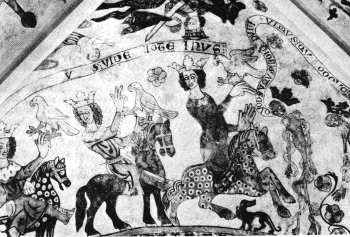
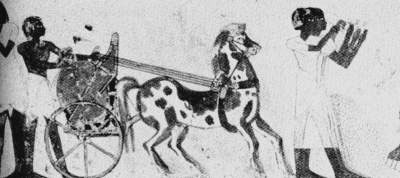
Wall Painting from Skibby Church, Sealand, Denmark
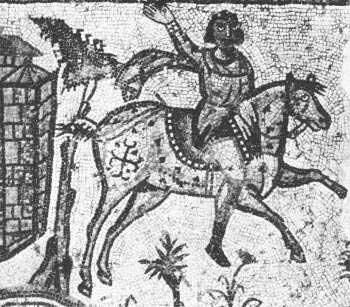
Carthagenean Mosaic
The Chinese emperor Wu Ti ( 2nd C. BC) eventually secured the "Heavenly Horses" of Ferghana (112 - 101 BC) to import to China to improve and replace the inferior native stock. Among those horses are depicted spotted horses. Chinese trade with the west insured a steady flow of improved horse flesh entering China. Spotted horses have
been common in China for the last 2000 years as evidenced in surviving art and
persist to present day.
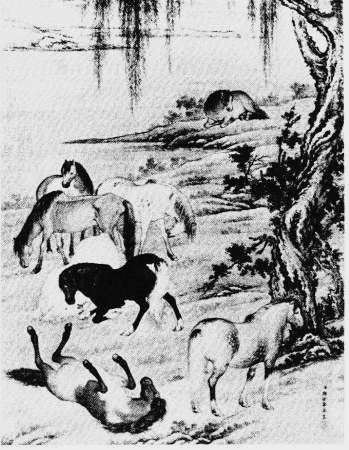
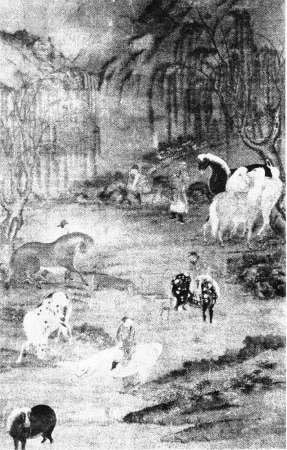
In the long and bitter Second Punic War (218 – 201 BC) the Carthaginians were defeated by Rome and thus the Romans took control of the Spanish peninsula. In the following centuries the horses of Spain were highly prized by the Romans and from that time on the horses of Spain have been considered to be the best in the world.
When the Iberian peninsula was conquered and subsequently controlled by the Goths (Germanic invaders from the north) 475 AD, Spanish horses diminished in numbers because the conquerors reserved exclusive use of horses to themselves. This kept the Goths superior to their conquered peoples and sharply reduced the danger of internal revolt. The absence of mounted enemies and the geographic protection afforded by the natural barriers of mountains and sea caused a sense of security from invasion for the Visigoths (western Goths). In time, the focus of horse breeding changed from the production of cavalry mounts requiring speed, courage and endurance to horses bred for beauty, and easy riding gaits. This neglect of cavalry focus left the Visigoths vulnerable.
The Persian plateau (modern Iran) passed from conqueror to conqueror until the arrival of the Muslims from the south in 640 AD. Art objects from that time to present show spotted horses (pinto and Leopard-complex). In spite of Mohammed's teachings, horses persisted in Persian art, leading to the conclusion that spotted horses were common in Persia since before the Muslim conquest.
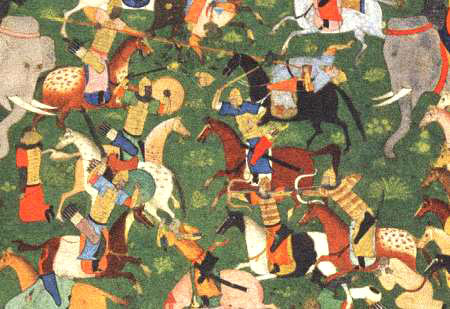
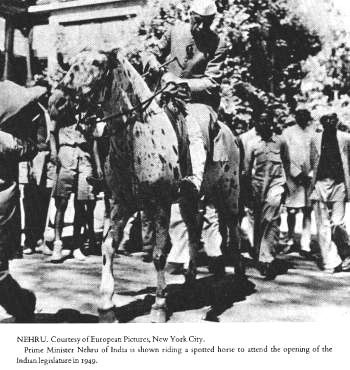
Prime Minister Nehru of India shown here riding a seemingly gaited, Leopard-complex horse to the opening of the Legislature in 1949.
Over time the mounted hordes of Islam coursed westward from Arabia, across Egypt and Libya, their numbers of fierce desert warriors increasing with every ever-westward campaign. The Straits of Gibraltar proved to be only a brief containment of the infidel. In 711 AD, over seven hundred years before Columbus set sail for the New World, the Moors invaded and conquered the Iberian Peninsula. With them the Moors brought Arabian and Berber horses (known as Barbs). These exceptional horses were more
than a little responsible for the history of their masters. In their midst were a number of pinto patterned Moroccan Barb horses. These pinto horses brought the pinto pattern to Spain and to the Spanish Jennet.
(In the late 1800s a pinto Moroccan Barb stallion was taken to England for breeding to Hackney and French
Coach Horse mares. From these breedings, the pinto pattern again crossed the Atlantic in 1907 as the
Morocco Spotted Horse. It was these horses that are credited with putting pinto patterning into today's
world of high performance saddle horses.)
Spanish resistance to the Moslem conquest organized in small centers in the rugged mountains of northwest Spain. Of necessity they adopted the cavalry equipment and tactics of their enemy. Thus, as the rest of the European continent concentrated on the production of massive horses to carry the heavy armor of knight to battle, the Spanish turned their focus to the production of a horse of medium size, with tremendous agility, strength, and heart. The horses of the Moorish conquerors were crossed with the Vilanas, a coarser native stock, the remnant of the horses brought across the Pyrenees from Gaul but previously improved by the cavalry minded Carthaginians. This is the horse that became the Andalusian. Some of those horses were spotted and possessed an easy riding gait. Like the pieces of a well planned puzzle each of the ancestral breeds contributed its finest traits:
the beauty of the Andalusian, the hardiness of the Barb, the elegance of the Arabian,
the easy riding gait of the Visigoths and some possessed the spotted coats of the horses
of ancient Spain, Persia, Asia Minor and Morocco. Thus emerged the famous:
Spanish Jennet.
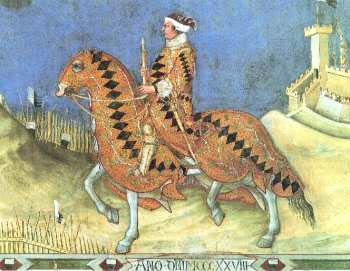
Inscribed 1328
As early as 1109 spotted horses appear in Spanish art and are a recurring phenomenon to the 17th Century. Spotted horses appear in French art from the 11th C. on. From the 12th C. on spotted horses begin to appear regularly in the art of Central Europe. Spotted horses in England began appearing during the 12th C. usually carrying saints or nobles.
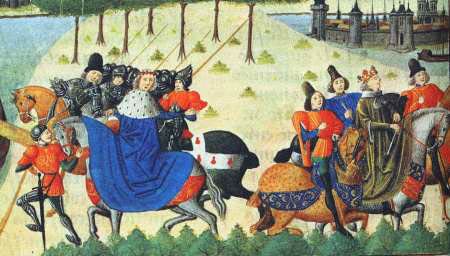
In 1492, after 700 years of Moorish occupation of the Iberian peninsula the combined forces of Aragon and Castile conquered the last remnant of the Muslim occupation at Granada. This victory by the Spanish set the stage for the next great campaign: the conquest of the New World. We know that spotted individuals were common in the horses of Spain during the period of conquest.
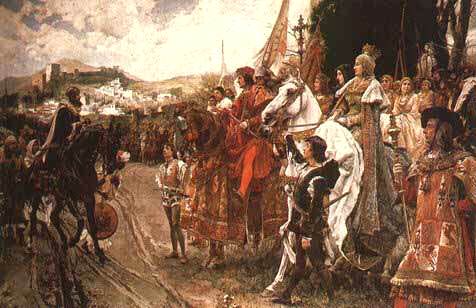
Spotted and easy gaited horses were abundant in the form of the Spanish Jennet at the time when Columbus selected twenty-five horses to take to the Americas on his second voyage. These horses were selected in Andalusia, the "cradle" for the very finest of Spanish horses including the Spanish Jennet. The comfortable gait, medium size and extraordinary athletic ability made the Spanish Jennet the obvious choice for the daunting task of exploring and conquering the vast unknown territory. Shipping manifests to the New World indicate that some spotted horses were in the group.
As the Spanish conquered more territory, horses were spread throughout the Caribbean. Horses were first taken to Puerto Rico in 1509 by Martin de Salazar. In 1511 Diego de Velasquez invaded Cuba with eight stallions and mares. In 1512 Spanish horses arrived at the Isthmus of Panama and in 1517 Cortez took seventeen horses to Mexico. The first horses arrived in Colombia in 1524.
" We will never know just exactly what horses were brought to the New World, but early records are of a wide variety of colors and markings. Some of the color names used to describe Cortez's horses are almost assuredly describing spotted horses as well as routine white marks. This is evidence that white marks and at least some body spotting patterns appear early in the Colonial Spanish era. These patterns, and white marks in general, therefore strike me as very consistent with an Iberian origin."
D. Phillip Sponenberg, DVM, PhD
In 1556 when Charles V, the Holy Roman Emperor, divided the House of Hapsburg he gave Spain to his son Philip II and Austria to his brother, Ferdinand. From time to time the monarchs exchanged lavish gifts. In 1560 a gift of horses from Philip II of Spain to his uncle, Ferdinand of Austria introduced spotted horses into Austria.
Nicolaes Berchem (1620-1683), Landscape with Two Horses
By 1550 many horse breeding and training centers had been established in the New World. The blood of the magnificent Spanish Jennet proved strong indeed, and horses with the smooth riding gait and extraordinary athletic ability were the most prized of all. These horses developed into the various strains of Paso horses know in South, Central and North America today - Paso Fino, Paso Colombiano, Puerto Rican Paso Fino, Peruvian Paso.
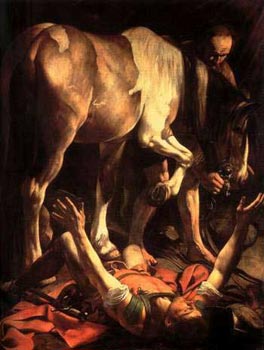
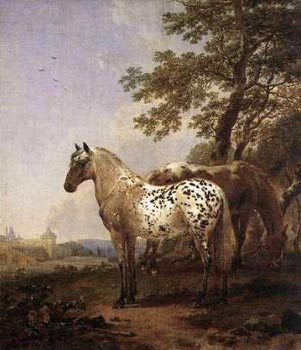
Caravaggio (Michelangelo Merisi),
The Conversion on the Way to Damascus,
Santa Maria del Popolo, Rome.
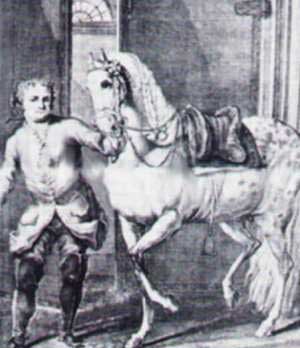
The gift was a group of Andalusian stallions and mares that eventually came to reside at the head of the Adriatic Sea at Equile Lipizzano. They came to be known as Lipizzans and were raised mainly to furnish mounts for the royal family of Austria. Art depicts a number
of horses at this stud as spotted. The training school at Vienna (training the horses originating in Spain - thus Spanish Riding School) displays pictures showing many of
the horses as spotted.
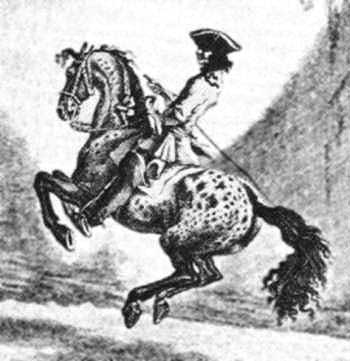
Johann Elias Ridinger 1760
As in Europe, so it went in the New World that after the flamboyant Baroque period (2nd half of the 16th C to the beginning of the 18th C) most Europeans and in the New World those mainly influenced by non-Iberian Europeans began to think of flashy colored horses as "vulgar". Remember: during this period of history many monarchies fell and the nobility was seeking anonymity in order to survive. Riding a flashy colored or patterned horse was in invitation to personal disaster. One of the few surviving monarchies was that of Spain.
From records, we discover that the Spaniards, Mexicans and Puerto Ricans maintained a keen interest in the exotic colors and patterns, and if not for that interest many interesting colors and patterns might have vanished forever. The unusual colors and the exotic patterns diminished in numbers by virtue of loss of favor with the public. In many areas of the European influenced world only the basic bay, gray, black and chestnut were desired and the Leopard-complex and pinto patterns disappeared. However spotted horses remained
in Spain, Mexico and Puerto Rico.
The spotted horses of Mexico made their way into the American southwest and continued steadily northward. An importation of spotted horses from Argentina helped to establish Leopard-complex (Lp) horses in the northwest, and there are records indicating that Leopard-complex horses also came to the northwest with Russian fur traders whose source was the Altai region of Russia. It is interesting to note that to this day there are wild herds in Eastern Russia that have Leopard-complex patterned individuals. It seems spots converged on the Americas from every direction. Easy riding exotic patterned horses were available and many of the "Foundation Appaloosas" were gaited. We will be looking to these animals to help reestablish that pattern in the modern Spanish Jennet horse.
The pinto gaited horse found favor in Puerto Rico and survives to this day as registered Paso Fino.
Discover the horse that discovered the Americas!
Ride a piece of history. Ride a Spanish Jennet Horse.
Art of spotted horses at the school during that period is prolific. The gift of the spotted horses was special indeed and their favor with the ruling class of Europe increased dramatically across Europe. The Spanish Jennet was the mount of choice of all European nobility, not just the Spaniards.
Louis XIV is depicted on a spotted horse during his reign as was Louis XV after him.
Louis XVI was driven by a team of spotted horses.
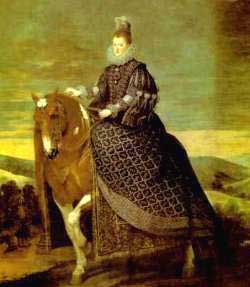
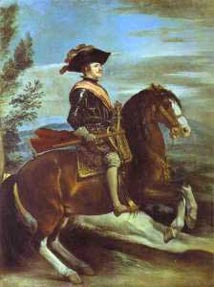
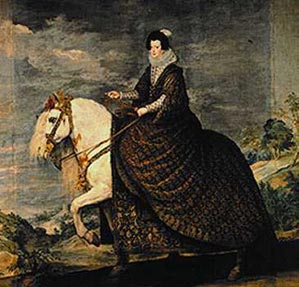
Philip IV - Velasquez Queen Margarita - Velasquez Queen Isabela of France - Velasquez
